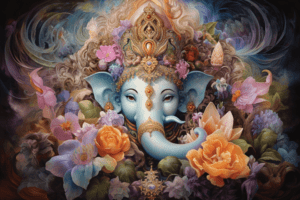Shanti Mantra For Great Peace
The Shanti Mantra is a sacred chant or prayer often used in Hinduism. It is recited to invoke peace and tranquility. There are different variations of the Shanti Mantra, and one of the most well-known versions is the “Om Asato Ma Sadgamaya” mantra. This mantra is often used in religious and spiritual ceremonies as a way to seek blessings and peace.

Shanti Mantra:
“Om Asato Ma Sadgamaya”
Sanskrit:
ॐ असतो मा सद्गमय।
तमसो मा ज्योतिर्गमय।
मृत्योर्माऽमृतं गमय।
Transliteration:
Om Asato Ma Sadgamaya
Tamaso Ma Jyotirgamaya
Mrityorma Amritam Gamaya
Translation:
1. Lead me from the unreal to the real.
2. Lead me from darkness to light.
3. Lead me from mortality to immortality.
This mantra is often chanted as a way to seek guidance, wisdom, and spiritual growth, while also wishing for the removal of ignorance and the attainment of eternal truth and immortality. It is a beautiful and profound expression of the human quest for truth and inner peace.
Uses Of Shanti Mantra
The Shanti Mantra, such as the “Om Asato Ma Sadgamaya” mantra, has several uses and purposes in Hinduism and spiritual practices. Here are some of the common uses and significance of the Shanti Mantra:
1. Invocation of Peace: The primary purpose of the Shanti Mantra is to invoke peace. It is chanted to create a harmonious and peaceful environment during religious and spiritual rituals.
2. Spiritual Growth: People often recite the Shanti Mantra as part of their meditation or yoga practice to seek spiritual growth and inner peace.
3. Beginning of Rituals: It is commonly recited at the beginning of various religious ceremonies, pujas (worship rituals), and spiritual gatherings to set a peaceful and sacred atmosphere.
4. Prayer for Guidance: The mantra is a prayer for guidance and wisdom. It expresses the desire to move from ignorance and illusion towards truth and enlightenment.
5. Removal of Darkness: The mantra is also used symbolically to seek the removal of darkness or ignorance from one’s life and the introduction of spiritual enlightenment.
6. Wishing Well-Being: By chanting this mantra, individuals wish for the well-being and prosperity of all living beings. It promotes the idea of universal peace and harmony.
7. Overcoming Fear of Death: The line “Mrityorma Amritam Gamaya” in the mantra is a prayer for overcoming the fear of death and attaining immortality of the soul.
8. Cultural and Spiritual Identity: The Shanti Mantra is deeply ingrained in Hindu culture and spirituality. It serves as a reminder of the core values and principles of Hinduism.
9. Educational and Academic Settings: In some educational institutions in India, the Shanti Mantra is chanted to start the day, promoting a calm and focused learning environment.
10. Personal Meditation: Many individuals use this mantra in their personal meditation practices as a means of calming the mind and connecting with their inner selves.
Overall, the Shanti Mantra serves as a powerful and meaningful tool for promoting peace, wisdom, and spiritual growth. It is a way to set intentions for a harmonious and enlightened life and to seek blessings for oneself and all beings.
How To Chant Mantra
Chanting the Shanti Mantra, such as the “Om Asato Ma Sadgamaya” mantra, can be a beautiful and spiritually uplifting practice. Here’s a step-by-step guide on how to chant the Shanti Mantra:
1. Find a Quiet and Peaceful Space:
– Choose a quiet and serene place where you won’t be disturbed. This could be a corner in your home, a meditation room, or a peaceful outdoor location.
2. Sit Comfortably:
– Sit in a comfortable and relaxed posture. You can sit cross-legged on the floor or use a chair if that’s more comfortable for you.
3. Set Your Intention:
– Before you start chanting, take a moment to set your intention. Reflect on why you want to chant the Shanti Mantra. It could be for inner peace, wisdom, or to invoke blessings.
4. Focus Your Mind:
– Take a few deep breaths to center yourself. Clear your mind of distractions and bring your focus to the mantra.
5. Chant the Mantra:
– Begin to chant the Shanti Mantra slowly and with devotion. You can chant it aloud or silently, depending on your preference.
– If you are unsure of the pronunciation, it’s a good idea to learn it from a knowledgeable source or teacher to ensure accuracy.
6. Use Mala Beads (Optional):
– Some people like to use mala beads (prayer beads) to help keep track of the number of times they chant the mantra. A traditional mala typically has 108 beads, and you can chant the mantra for each bead.
7. Visualize the Meaning:
– As you chant, visualize the meaning of the mantra. Envision yourself moving from darkness to light, from illusion to truth, and from mortality to immortality.
8. Meditate or Reflect:
– After you have chanted the mantra for the desired number of times (it can be chanted 3, 9, 27, or 108 times), sit in silent meditation or reflect on the mantra’s meaning.
9. Express Gratitude:
– Conclude your practice by expressing gratitude. Thank the universe, your higher power, or the divine for the peace, wisdom, and blessings you seek.
10. Practice Regularly:
– Chanting the Shanti Mantra can be a daily practice or done on special occasions. Consistency in your practice can enhance its spiritual benefits.
Remember that the Shanti Mantra is not just about the words but also about the intention and devotion with which you chant it. Over time, this practice can bring inner peace and a deeper connection to your spiritual self. It can be a powerful tool for personal growth and well-being.






